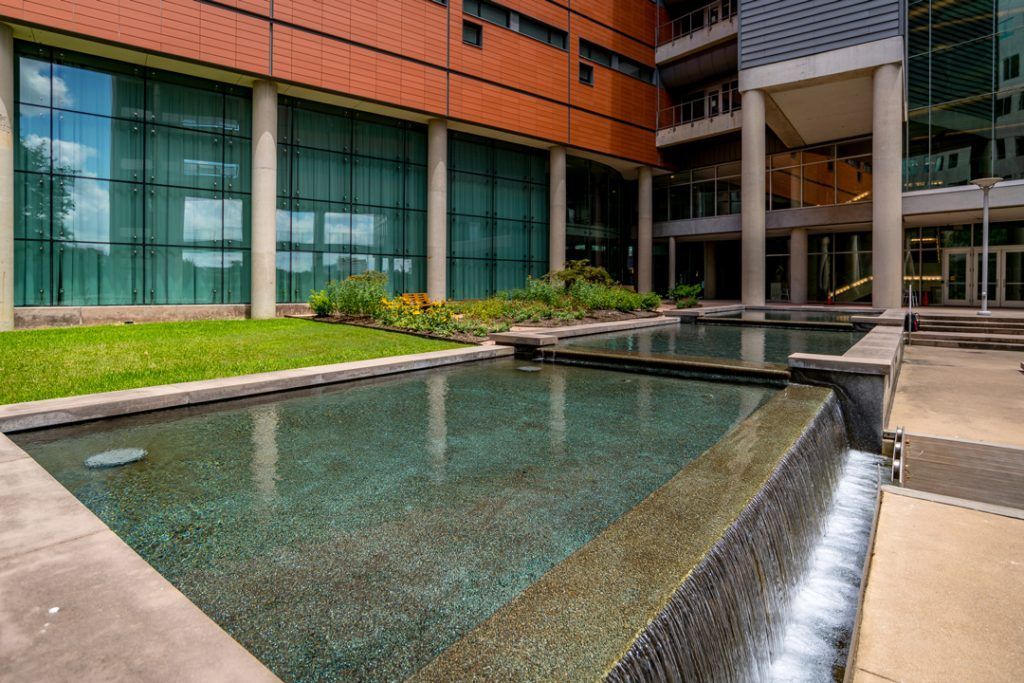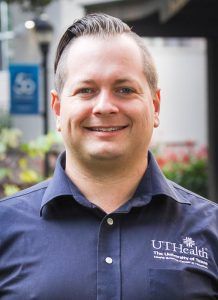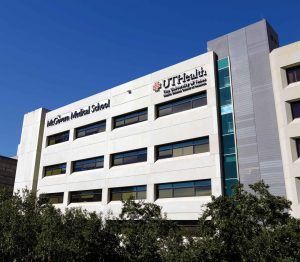The first class of 19 students entered what is now known as McGovern Medical School at The University of Texas Health Science Center at Houston (UTHealth) in 1970. Located in the heart of the Texas Medical Center, the school was established by the Texas Legislature in 1969 to address the shortages of physicians and the then-untapped resources for medical education in Houston.
Growing from a facility with no buildings to one of the nation’s outstanding centers of academic medicine, the McGovern Medical School at UTHealth continues to be devoted to medical education, research, quality patient care and community outreach—clocking in as one of the largest and most diverse medical schools in the United States, who along with access to the latest technology, are taught with an emphasis on humanities, ethics, patient quality and safety.
Affiliated with several inpatient hospitals and outpatient facilities, the McGovern Medical School at UTHealth provides a broad range of clinical services, including its primary teaching hospital, Memorial Hermann-Texas Medical Center, which recently was named the second top teaching hospital in the country.
Today, there are various construction projects happening at the McGovern Medical School at UTHealth. To get an in depth look at where they stand, we sat down with Clinton “Brooks” Herman, CEFP, PMP at UTHealth.
Give us a snapshot of one of your current projects.
There are many research lab projects going on, from a bio-safety cabinet swap, replacement of tunnel wash/autoclaves, integration of emergency power for an electron microscope, and starting the programming/design work for several large lab projects. All of these are for our McGovern Medical School at UTHealth, housed in our largest building on campus, which covers one million square feet.
What were the goals of the project? How did they change when the pandemic hit?
Each of the projects are for world-renowned researchers seeking out breakthrough medical advances to share with the world. These projects were not affected by the pandemic directly, but it took a little more time to coordinate with the revised schedules our researchers/staff/contractors working to maintain social distancing and safety for all.
Pre-bid walks have also changed due to the current pandemic. To help reduce the number of people participating in pre-bid walks, our Procurement Team no longer attends. We also have asked contractors to limit the numbers of employees they are inviting to the pre-bid walk.

Tell us about the immediacy of the construction deadline. How did that factor into the planning?
The projects’ requirement for urgency is predicated on the fact that the researcher will likely not able to continue their research, or may be hindered in the meantime. Our tunnel wash is still active and able to be used, but is approaching the end of useful life, and will continue to become more difficult to keep operating until replacement.
Our autoclave is currently down due to it reaching end of useful life, and therefore the lab is having to utilize a nearby autoclave outside of their existing space. Our electron microscope is very sensitive to power fluctuations, so we are adding on UPS battery backup along with an automatic transfer switch to reduce any blips caused when the system moves to the house generator.
This project also is part of a larger building-wide electrical maintenance program to ensure our system are functioning properly.
What goes into enacting a design and construction plan at that pace?
Following up and setting specific deadlines for all parties, including myself, help to keep the pace moving forward. If it is necessary for an above normal turnaround for plan or submittal review, it should be discussed beforehand with the architect/engineer, and any UTHealth stakeholders, so all parties are on board and are headed in the same direction/pace as the project requires.
What special precautions (protocols) were put into place?
All typical protocols that it takes to maintain existing lab equipment and allow research to continue around the projects were put into place. This could include special containment for dust control with negative air in the construction space, or as minor as draping plastic containments over bench work and removing the debris for the drape.
With COVID-19, we are able to reduce runtimes for the air in our administrative buildings, but still work to make sure lab/research facilities maintain the necessary temperatures.
Were there any challenges?
All projects have their challenges. It is about how you approach and manage each challenge. It is possible to miss scope in the project; we have a contingency in place. Or if the lab has an added request due to the ever-changing research world, we step back and try to see how to accommodate each issue.
Recently one lab added scope for a Millipore water filter. Fortunately, each mechanical chase already has reverse osmosis nearby, but this adjustment had to be made quickly, as the project was nearing completion.
How does the overall design of the lab cater to what the facility managers were looking for?
Our teams are currently working on adding new energy conservation measures, including in our labs. We are working on implementing our newest lab casework specification inside McGovern Medical School. In a building that size, it is important to standardize fixtures and finishes for routine maintenance as well as for the potential unforeseen emergencies like water leaks.
As a team, the project management group has worked with both the school and the maintenance team to identify and standardize items. This allows us to keep routine items in stock, which limits down times when unplanned events happen.
What kind of conversations are you having about the “new normal?”
All contractors are required to agree to our university COVID-19 procedures. In addition, we discuss site specific COVID-19 plans, which include topics such as phasing lunch breaks, limiting the numbers of workers in confined areas, routine cleaning of high touch areas and reporting of COVID-19 positive incidents.
During owner/architect/contractor meetings, there is continued review all reports and procedures, including wearing masks and keeping up with cleaning high-touch surfaces.
With everything going on today, what’s your short-term strategy? Long-term?
Short-term – Masks are required by all contractors, max elevator capacities, added sanitation dispensers around campus, high touch surfaces wiped down often, online OAC meetings versus in person.
Long-term – This is still in development, but it is likely that the sanitation dispensers will become routine fixtures on campus, along with increased wiping of high touch surfaces.
What’s the best piece of advice you can offer on how to deal with what’s happening right now?
It is best to see what your local jurisdiction is doing, and at least follow these standards for a minimum. If it is feasible to make additional adjustments, that is in the best interest of your employees and business.
Give us a rundown of what you’re seeing out there.
We have noticed a slowdown in some requests for projects, but we are working on bringing our UTHealth footprint back on campus with less lease space. This is due to many employees now working remotely.
Lab research projects continue to come up, which means our researchers are continuing to receive grants and need to adjust their spaces with the changing times in research, or their new project has different needs than before.
What’s the biggest issue today related to the construction side of the business?
We have noticed a slowdown in some materials that are coming from overseas due to COVID-19, but this has not had a great impact on most of our projects to date.
Talk about the continued importance of sustainability today. What are you doing?
UTHealth Facilities, Planning & Engineering has established an Energy Conservation Opportunity team. This team meets monthly to review and discuss energy savings opportunities on campus. We have implemented measures such as zone presence sensors for chemical fume hoods, occupancy sensors, LED retrofits, condensation recovery and retro commissioning.
In addition, we have taken opportunities to replace aging equipment that is more efficient, along with our teams working to program the buildings to help gain in on energy conservation opportunities. With COVID-19, we are able to reduce runtimes for the air in our administrative buildings, but still work to make sure lab/research facilities maintain the necessary temperatures.
What type of opportunities do you see moving ahead?
Solar is making large strides, just recently they made a breakthrough with the material used for the panels (perovskite) that has a potential of +60% efficiency versus conventional silicon panels ~14%. This would assist in the size of your “solar farm” necessary to power your buildings, and may allow roofs to be more useful.
What are some of the things you expect to see, if and when, we get back to any type of normalcy?
For ongoing safety, I expect people will continue to avoid large gatherings. In the office, we are noticing more productive meetings by utilizing web conferencing versus face to face. Face to face interactions will still have their place, as they are still pertinent to see the construction site in person.
From what you are seeing out there now? How would you say the industry is handling construction in this new landscape?
The industry is handling it the best they can, facemasks have become an essential piece of PPE, which already had a place in some facets of the business anyway.What should we expect to see six, 12 months down the road?
Hopefully, we continue to see construction growth. I suspect distribution centers will grow in numbers as more and more are shopping online versus going in store. And online and big-box retailers will continue to offer quicker delivery times.
____________________________________________________________
 One-on-One with…
One-on-One with…
Clinton “Brooks” Herman, CEFP, PMP
Describe a typical day.
Other than the obligatory cup or two of coffee, a typical work day starts with a review of emails. Second, reviewing all email flags that were set for the day and sending out requests/follow ups to the flags. Then, a review of what actions needed for any active projects and checking off the tasks one by one.
After hopefully starting this way, the day becomes very open ended, maybe a random phone call for an issue to resolve, a new project just landed on your desk and you need to schedule a meeting with the client, or an unfortunate leak comes up and needs immediate attention. The day in the life of a project manager is usually never the same. Unpredictability is what we strive to settle.
What’s the biggest item on your to-do list right now?
Continuing my MBA course load with the normal work day, and prepping for becoming a father.
What’s the most rewarding part of your job?
Every project is rewarding just by seeing the finished product and plan come to fruition of how you intended it at the beginning. It is always best to hear words of encouragement from your clients that the project met their needs or exceeded their expectations.
What was the best advice you ever received?
Take a step back and enjoy the fruits of your labor every once in a while. We can all get lost in the weeds of our day to day lives and forget why we are working on each task.
What’s the best thing a client ever said to you?
The satisfaction that the project was completed ahead of schedule and under budget, and completely met or exceeded their expectations.
How do you like to spend your down time?
My wife, Briana, and I enjoy spending time with our two dogs, Ollie and Stella. Ollie is a full miniature Australian Shepherd full of energy, while Stella is our baby, a mutt with maybe some greyhound, as she can outrun most dogs. We are preparing to have our first child—a boy in early 2021. This has provided some new meaning to down time and utilizing it to the fullest.
Otherwise, right now, you will find me studying my MBA courses with an expected end of 2021 completion.












